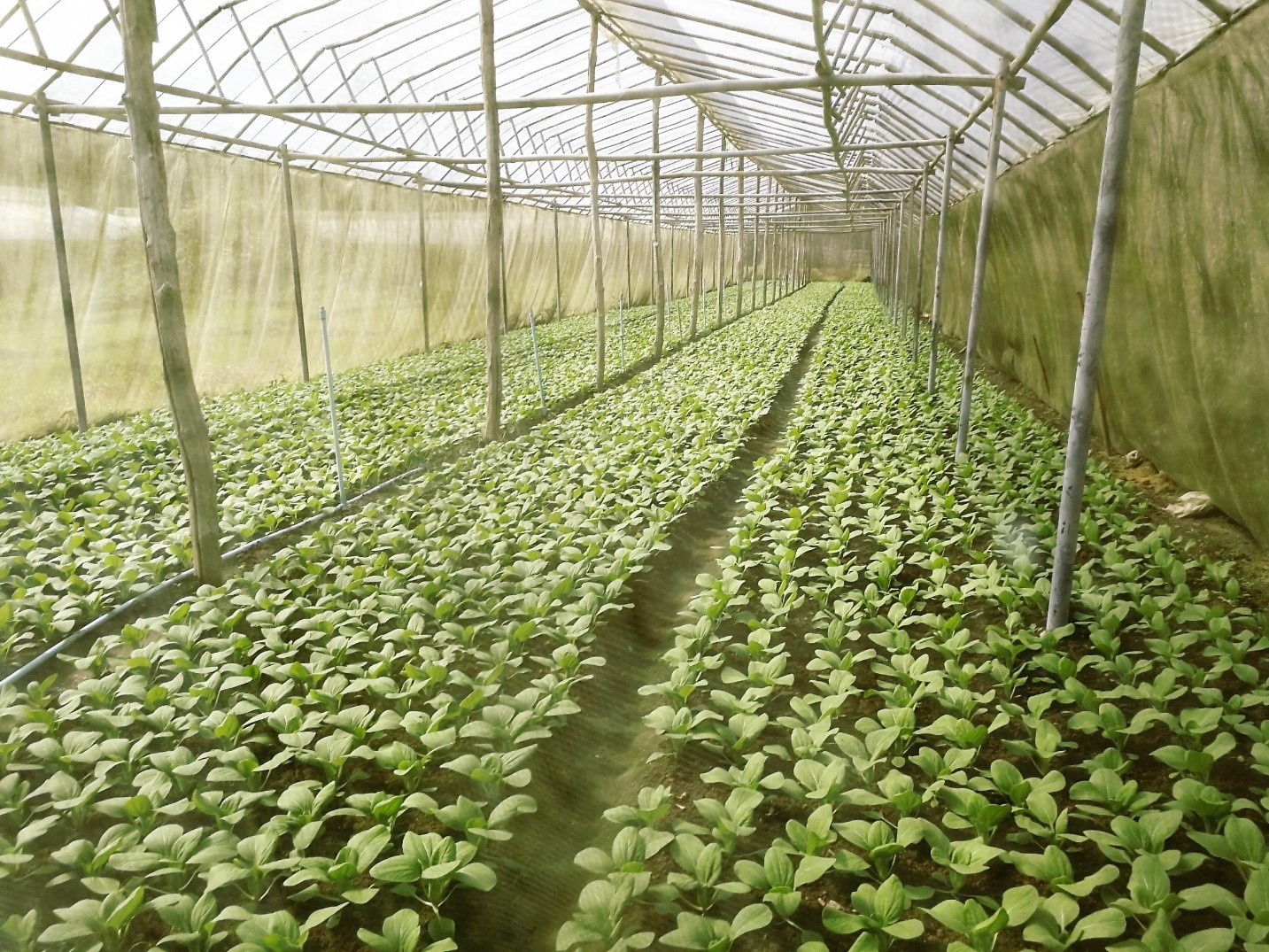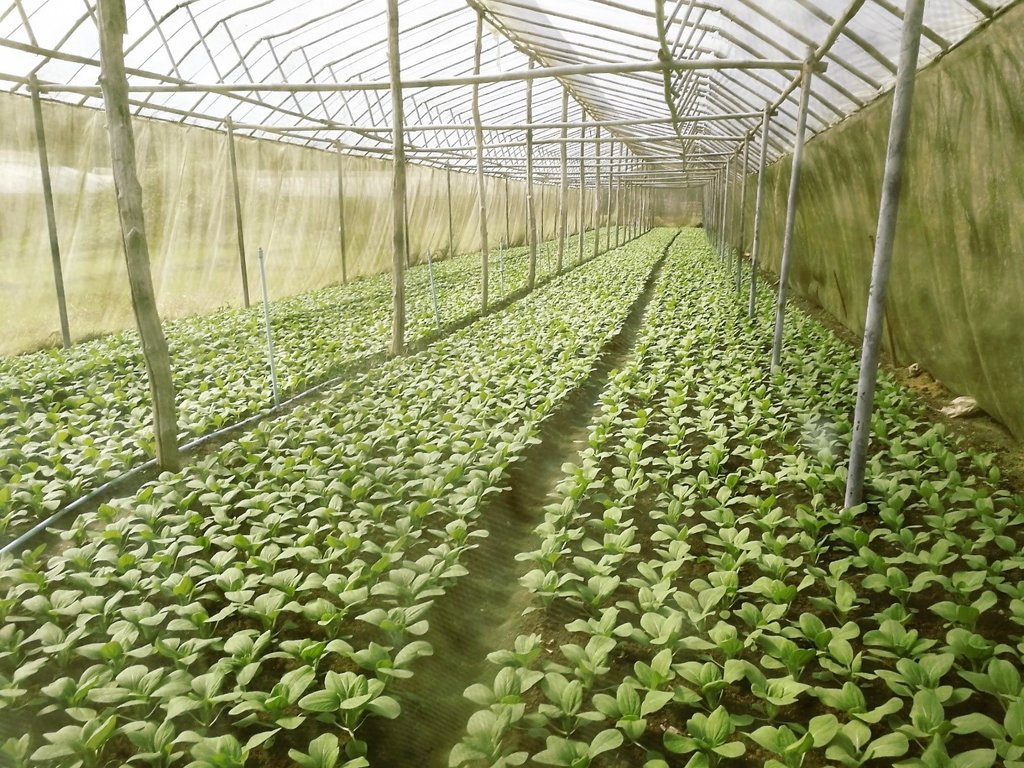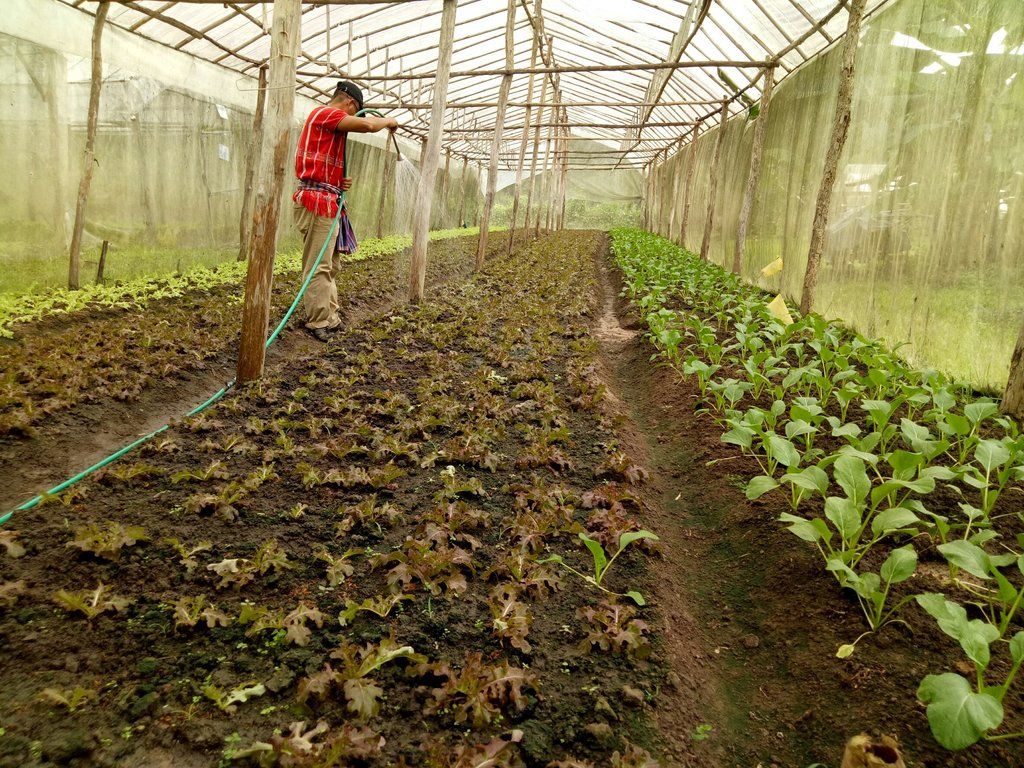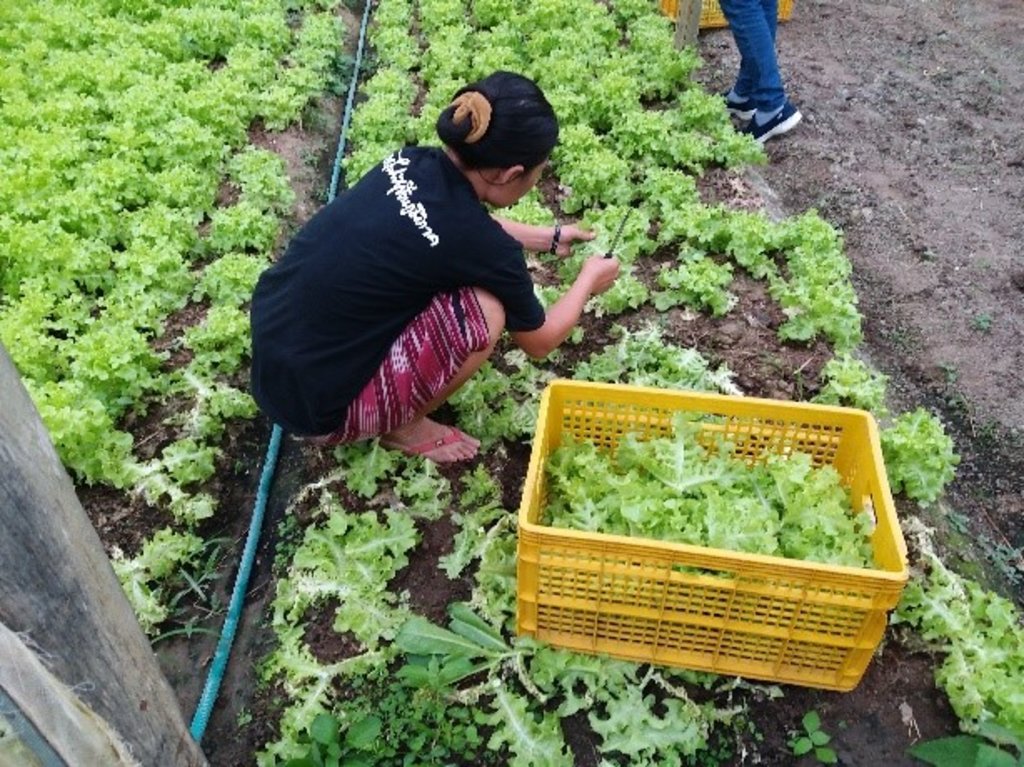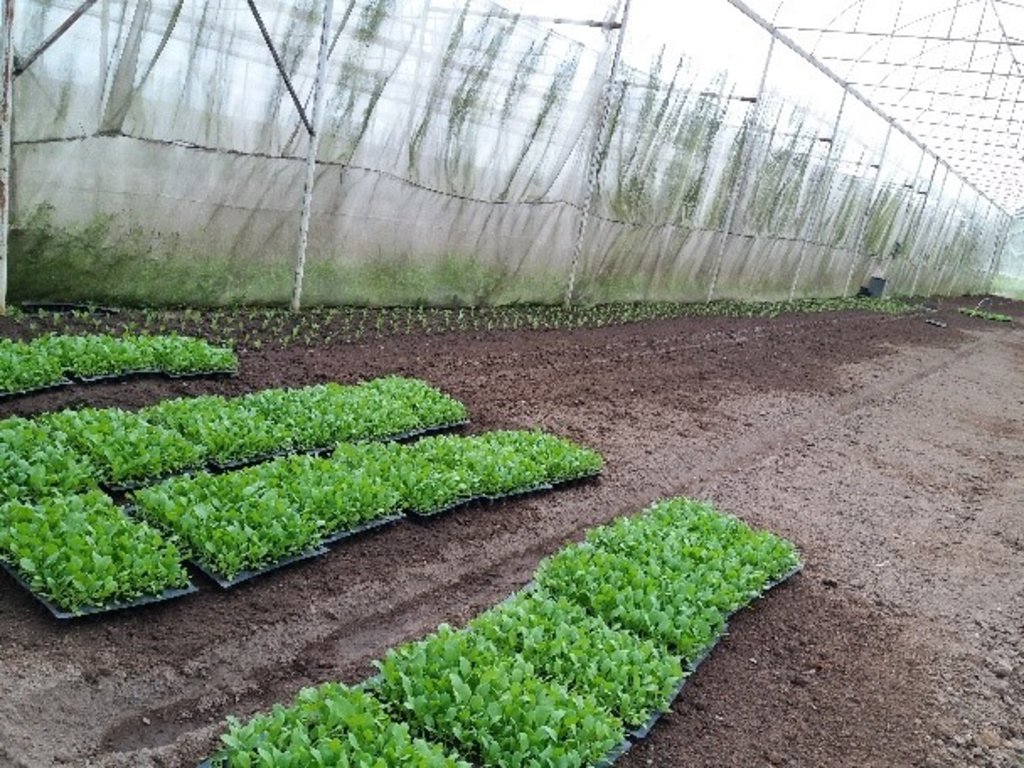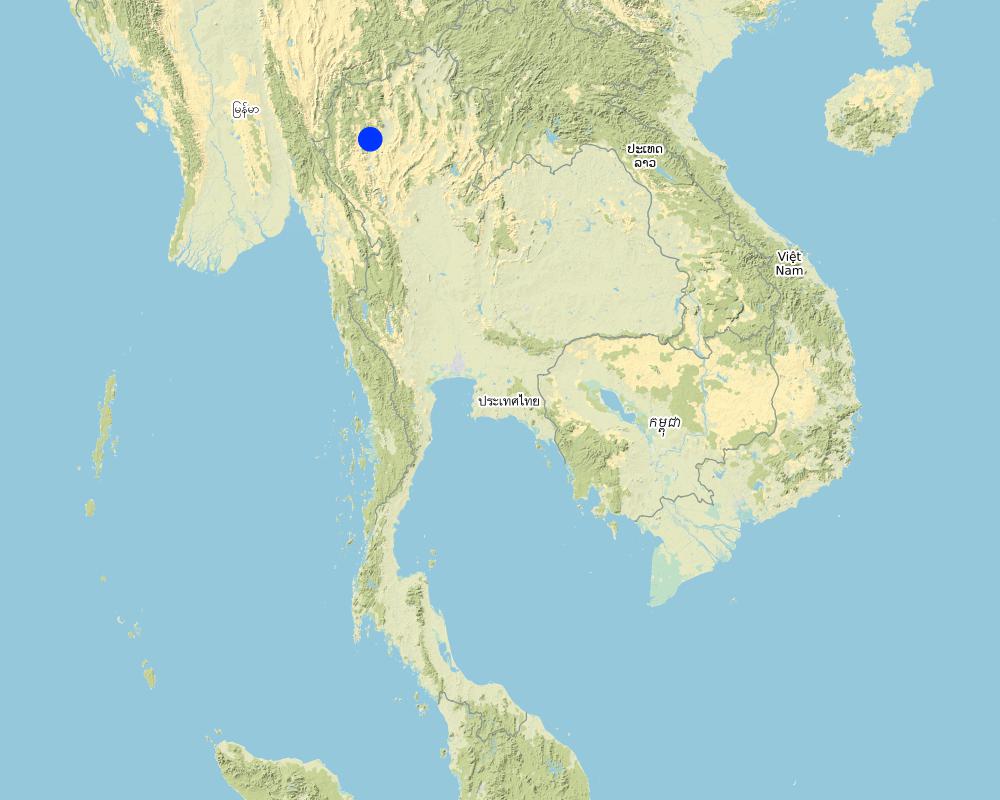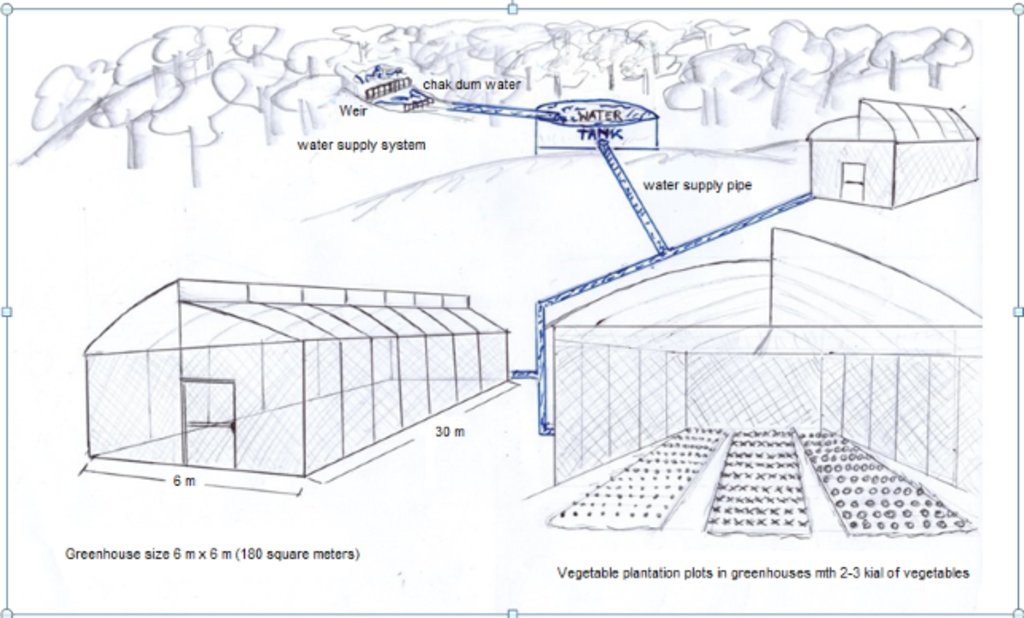Integrated Soil Management for Organic Vegetables on the Highland Watershed in the Northern Region [ប្រទេសថៃ]
- ការបង្កើត៖
- បច្ចុប្បន្នភាព
- អ្នកចងក្រង៖ Pitayakon Limtong
- អ្នកកែសម្រួល៖ –
- អ្នកត្រួតពិនិត្យច្រើនទៀត៖ Rima Mekdaschi Studer, William Critchley
Organic vegetables in the Royal Project
technologies_4283 - ប្រទេសថៃ
ពិនិត្យមើលគ្រប់ផ្នែក
ពង្រីកមើលទាំងអស់ បង្រួមទាំងអស់1. ព័ត៌មានទូទៅ
1.2 ព័ត៌មានលម្អិតពីបុគ្គលសំខាន់ៗ និងស្ថាប័នដែលចូលរួមក្នុងការវាយតម្លៃ និងចងក្រងឯកសារនៃបច្ចេកទេស
បុគ្គលសំខាន់ម្នាក់ (ច្រើននាក់)
co-compiler:
Wattanaprapat Kamalapa
Land Development Department
ប្រទេសថៃ
អ្នកប្រើប្រាស់ដី:
Phojanabandit Watcharin
Headman of village
ប្រទេសថៃ
local extension officer:
Kerephuwadon Boontre
Inthanon Royal Agricultural Station, the Royal Project
ប្រទេសថៃ
local LDD officer:
Intha Charun
Royal Project Land Development Center, Land Development Office Region 6, Land Development Department.
ប្រទេសថៃ
ឈ្មោះអង្គភាពមួយ (ច្រើន) ដែលបានចងក្រងឯកសារ/ វាយតម្លៃបច្ចេកទេស (បើទាក់ទង)
Land Development Department LDD (Land Development Department LDD) - ប្រទេសថៃ1.3 លក្ខខណ្ឌទាក់ទងទៅនឹងការប្រើប្រាស់ទិន្នន័យដែលបានចងក្រងតាមរយៈ វ៉ូខេត
អ្នកចងក្រង និង(បុគ្គលសំខាន់ៗ)យល់ព្រមទទួលយកនូវលក្ខខណ្ឌនានាទាក់ទងទៅនឹងការប្រើប្រាស់ទិន្នន័យដែលបានចងក្រងតាមរយៈវ៉ូខេត:
បាទ/ចា៎
1.4 សេចក្តីប្រកាសស្តីពីចីរភាពនៃការពណ៌នាពីបច្ចេកទេស
តើបច្ចេកទេសដែលបានពណ៌នានេះមានបញ្ហាដែលផ្តោតលើការធ្លាក់ចុះគុណភាពដី, បើដូច្នេះវាមិនអាចត្រូវបានប្រកាសថាជាបច្ចេកទេសនៃការគ្រប់គ្រងប្រកបដោយចីរភាពទេ?
ទេ
មតិយោបល់:
Organic vegetable production is a technology that prevents and restores land degradation due to soil management emphasized in using organic and natural materials to improve soil fertility and productivity, especially in terms of soil organic matter.
2. ការពណ៌នាពីបច្ចេកទេស SLM
2.1 ការពណ៌នាដោយសង្ខេបពីបច្ចេកទេស
និយមន័យបច្ចេកទេស:
Organic vegetable cultivation on the highland area of the northern region of Thailand has been encouraged by local officers in order to produce safe food on degraded land through building up soil fertility and soil organic matter.
2.2 ការពណ៌នាលម្អិតពីបច្ចេកទេស
ការពណ៌នា:
This case study is of organic vegetable cultivation at Ban Muang Ang Village which is located in Ban Luang Sub-district, Chom Thong District, Chiang Mai Province, covering approx. 25,881 Rai (6.25 rai = 1 ha; 625 rai = 1 sq km). The topography is a complex mountainous area within the Doi Inthanon National Park, at an elevation of 600-800 m asl. The climate is quite cool and humid with average temperature throughout the year being 20⁰C. The average annual rainfall is 2,000-2,100 mm. Most of the population belong to the Pakhayo hilltribe, living in 219 households, with total population of 588 persons (308 males, 280 females). The main purpose of promoting growing organic vegetables in greenhouses is to change their way of life from forest encroachment/ shifting cultivation in the upper watershed, to improving the ecosystem services and environment with better health and higher incomes for villagers.
Since 2002, the government and the Royal Project Foundation have had a policy to change land use to organic farming. At the early stage, yields of organic vegetables were not good. In the year 2010, the Inthanon Royal Agricultural Station brought a number of these land users to visit the Mae Tho Royal Project Development Center in Bo Sali Sub-district, Hot District, Chiang Mai Province. They obtained knowledge about organic cultivation in simple greenhouses made from bamboo poles, covered with plastic sheets and nylon nets. Local officers of the Inthanon Royal Agricultural Station supported with education, offered suggestions and recommended practices, as well as finding markets to sell the organic products; that became the model. It took only 25-30 days for a crop, and they could harvest about 200 kg of vegetables per greenhouse. They could produce 11 crops of vegetables in one year, which means that they could earn 10 times more income than before. At present, Muang Ang Village there are 153 members operating in 270 greenhouses which is the largest organic vegetable production area in the Inthanon Royal Project.
The production of organic vegetables in this area is outstanding. This network has received certification from the Department of Agriculture (DOA) and the Office of Organic Agriculture Certification Thailand (ACT Organic). Farmers or farming enterprises certified by this system are entitled to apply the logos and certification card of ACT Organic and IFOAM Accredited brand on their products. Moreover, the Agri-Food & Veterinary Authority of Singapore (AVA) has approved the production processes. Every production step has been approved through the standard regulation of each agency with tracking to the source of production inputs such as fertilizers, disease, weed and pest control measures, cultivation practices, etc. Now they have nine types of vegetables that constitute the main production: Choy, Baby Emperor, Cos Salad, Green Oak, Red Oak, Fille Iceberg, String Bean, Kale Hong Kong and Baby Carrot.
2.3 រូបភាពនៃបច្ចេកទេស
កំណត់សម្គាល់ទូទៅនៃរូបថត/រូភាព:
The simple nursery is 6 meters wide, 30 meters long, and 5 meters high. Organic vegetable seed is supported from the Royal Project with ready to planting into the plot.
2.4 វីដេអូនៃបច្ចេកទេស
កាលបរិច្ឆេទ:
13/09/2018
ទីតាំង:
Moo 9, Ban Mung Aung Village, Ban Luang Sub-district, Chom Thong District, Chiang Mai Province
ឈ្មោះអ្នកថតវីឌីអូ:
Ms. Kamalapa Wattanaprapat
2.5 ប្រទេស/តំបន់/ទីតាំងកន្លែង ដែលបច្ចេកទេសត្រូវបានអនុវត្ត និងបានគ្រប់ដណ្តប់ដោយការវាយតម្លៃនេះ
ប្រទេស:
ប្រទេសថៃ
តំបន់/រដ្ឋ/ខេត្ត:
Ban Luang Sub-district, Chom Thong District, Chiang Mai Province
បញ្ជាក់បន្ថែមពីលក្ខណៈនៃទីតាំង:
Inthanon Royal Agricultural Station
បញ្ជាក់ពីការសាយភាយនៃបច្ចេកទេស:
- អនុវត្តនៅកន្លែងជាក់លាក់មួយ/ ប្រមូលផ្តុំនៅតំបន់តូចៗ
មតិយោបល់:
This activity is the integrated implementation project of the Royal Project in collaboration with other government agencies.
Map
×2.6 កាលបរិច្ឆេទនៃការអនុវត្ត
បង្ហាញឆ្នាំនៃការចុះអនុវត្ត:
2002
ប្រសិនបើមិនច្បាស់ឆ្នាំ សូមបញ្ជាក់កាលបរិច្ឆេទដែលប្រហាក់ប្រហែល:
- 10-50 ឆ្នាំ
2.7 ការណែនាំពីបច្ចេកទេស
សូមបញ្ជាក់តើបច្ចេកទេសត្រូវបានណែនាំឱ្យអនុវត្តដោយរបៀបណា:
- តាមរយៈគម្រោង / អន្តរាគមន៍ពីខាងក្រៅ
មតិយោបល់ (ប្រភេទនៃគម្រោង ។ល។):
All knowledge and technology is supported by the Royal Project collaboration with Land Development Department and other government and private agencies.
3. ចំណាត់ថ្នាក់នៃបច្ចេកទេស SLM
3.1 គោលបំណងចម្បង (១ ឬច្រើន) នៃបច្ចេកទេសនេះ
- អភិរក្សប្រព័ន្ធអេកូឡូស៊ី
- អភិរក្ស/ធ្វើឱ្យប្រសើរឡើងជីវចម្រុះ
- បង្កើតផលប្រយោជន៍សេដ្ឋកិច្ច
3.2 ប្រភេទដីប្រើប្រាស់មួយប្រភេទ (ច្រើនប្រភេទ) ដែលបានអនុវត្តបច្ចេកទេស

ដីដាំដំណាំ
- ដំណាំប្រចាំឆ្នាំ
សូមបញ្ជាក់:
Vegetables: Cantonese, Baby Emperor, CosSalad, Oak leaf Green, Oak leaf Red, Guest Bean, Filler Iceberg, Kale Hong Kong and Baby Carrot.

ផ្លូវទឹក ផ្ទៃទឹក ដីសើម
ផលិតផល/សេវាកម្មចម្បង:
Irrigation water from a storage tank at the upper part, through PVC pipes to the area cultivated to the organic vegetables.
មតិយោបល់:
In the past, villagers had encroached on forest areas and deforestation in highland for shifting cultivation, and also expand cultivation area into steep slope. Resulting in the destruction of forest areas and accelerated soil degradation. Villagers have low incomes: not enough to survive. But due to the grace of His Majesty King Bhumibol Adulyadej, King Rama 9 set up the Royal Project to distribute knowledge and education to all farmers in this area, and assist them to have better occupation and living standards.
3.3 បន្ទាប់ពីអនុវត្តបច្ចេកទេស តើដីប្រើប្រាស់មានការប្រែប្រួលដែររឺទេ?
មតិយោបល់:
The Royal Project has promoted the production of organic vegetables. Farmers therefore have changed from shifting cultivation to organic agriculture with sustainable soil management. As well as returning from forest areas and conserving soil, water and forest resources, maintaining ecological balance, this all makes villagers lives better. According to the cultivation schedule provided by the Royal Project, this area can cultivated throughout the year due to the development of irrigation systems from the storage tank in the upper part and supply to each plot of this targeted area.
3.4 ការផ្គត់ផ្គង់ទឹក
ផ្សេងៗ (ឧ. ក្រោយពីទឹកជំនន់):
- water from watershed area
មតិយោបល់:
Water resources are obtained from watercourses in the watershed, with a small dam which collects water in a reservoir. A PVC pipe is connected from the reservoir to individual plots and this irrigation system allows allocation to every farmer by the water management group.
3.5 ក្រុម SLM ដែលបច្ចេកទេសស្ថិតនៅក្នុង
- ប្រព័ន្ធដំណាំបង្វិល (ការដាំដំណាំវិលជុំ ការទុកដីចោលដើម្បីបង្កើនជីជាតិ កសិកម្មពនេចរ)
- បញ្ចូលការគ្រប់គ្រងសត្វល្អិត និងជំងឺតាមបែបចម្រុះ (រួមទាំង កសិកម្មសរីរាង្គ)
- ការគ្រប់គ្រងប្រព័ន្ធស្រោចស្រព (រួមទាំងការផ្គត់ផ្គង់ទឹក ប្រព័ន្ធបង្ហូរ)
3.6 វិធានការ SLM ដែលបញ្ចូលនូវបច្ចេកទេស

វិធានការក្សេត្រសាស្ត្រ
- A2: សារធាតុសរីរាង្គ/ជីជាតិដី

វិធានការគ្រប់គ្រង
- M2: ការផ្លាស់ប្តូរការគ្រប់គ្រង/ កម្រិតអាំងតង់ស៊ីតេ
មតិយោបល់:
-
3.7 កំណត់ប្រភេទនៃការធ្លាក់ចុះគុណភាពដីសំខាន់ៗដែលបច្ចេកទេសនេះបានដោះស្រាយ

ការហូរច្រោះដីដោយសារទឹក
- Wt: ការបាត់ដីស្រទាប់លើដោយការហូរច្រោះ

ការធ្លាក់ចុះសារធាតុគីមីក្នុងដី
- Cp: ការបំពុលដី

ការធ្លាក់ចុះជីវសាស្ត្រនៃដី
- Bl: ការបាត់បង់មីក្រូ និងម៉ាក្រូសរីរាង្គរបស់ដី
- Bp: ការកើនឡើងនូវសត្វល្អិត ឬជំងឺ បាត់បង់នូវសត្វមានប្រយោជន៍
មតិយោបល់:
Organic vegetable production in greenhouses can solve the problem of soil erosion with utilization of compost, animal and green manure to increase fertility and organic matter.
3.8 ការពារ កាត់បន្ថយ ឬស្តារឡើងវិញនៃការធ្លាក់ចុះគុណភាពដី
បញ្ជាក់ពីគោលដៅរបស់បច្ចេកទេស ដែលផ្តោតទៅការធ្លាក់ចុះគុណភាពដី:
- ការការពារការធ្លាក់ចុះគុណភាពដី
- ការកាត់បន្ថយការធ្លាក់ចុះគុណភាពដី
មតិយោបល់:
This organic vegetable production on very steep land can prevent and reduce soil erosion. Moreover, organic material and fertilizers can restore and improve soil fertility and productivity.
4. បច្ចេកទេសជាក់លាក់ សកម្មភាពអនុវត្ត ធាតុចូល និងថ្លៃដើម
4.1 គំនូសបច្ចេកទេសនៃបច្ចេកទេសនេះ
លក្ខណៈពិសេសនៃបច្ចេកទេស (ទាក់ទងនឺងគំនូរបច្ចេកទេស):
Operating procedures
1. Establishment of networks: All land users set up networks of organic vegetable producers and register the members properly; all members must act strictly according to the regulations.
2. Integrated cooperation: The Inthanon Royal Agricultural Station and the Inthanon Highland Agricultural Extension Center organize training on organic farming at least once a year, including study trip/s to visit other successful organic farmers.
3. Selection of the area: Leaders and members select the area for members, each member occupying not more than three greenhouses, 6m wide, 30m long and 3-5m high (180 sq m).
4. Production planning: land users discuss with the staff of the Inthanon Royal Agricultural Station, and plan the production schedule and types of vegetables to meet the market demand.
5. Procurement of production inputs: Both of local officers with inspectors and farmers can buy production inputs by themselves. All materials must be organic and are from reliable sources. Farmers must be very careful in this matter.
6. Organic vegetables cultivation: All land users must strictly comply with the schedule of cultivation, practices in soil improvement, control of pests and diseases, plus recording every step of their activities.
7. Production monitoring: Staffs of the Inthanon Royal Agricultural Station and Department of Agricultural Extension (DOAE) monitor and observe land users’ practices in using soil improvement methods and using bioproducts for controlling insects, predators, parasites and diseases. Department of Agriculture (DOA) and the Organic Agriculture Certification Thailand (ACT Organic) monitor the production process.
8. Harvesting of Products: All land users must harvest according to the harvesting schedule and the preservation methods. DOA and ACT Organic serve as certification agencies by analyzing the contamination of substances in the products.
9. Screening and packing: All land users must clean their products with non-contaminated equipment, and also screen the quality and specified size/s of products for delivery to the Inthanon Royal Agricultural Station.
ឈ្មោះអ្នកនិពន្ធ:
Ms.Kamalapa Watanaprapat
កាលបរិច្ឆេទ:
25/10/2018
4.2 ព័ត៌មានទូទៅដែលពាក់ព័ន្ធនឹងការគណនាធាតុចូល និងថ្លៃដើម
កំណត់របៀបនៃការគណនាថ្លៃដើម និងធាតុចូល:
- ក្នុងតំបន់អនុវត្តបច្ចេកទេស
កំណត់ទំហំ និងឯកត្តាផ្ទៃដី:
70 rai
បើសិនប្រើឯកតាតាមតំបន់ សូមបញ្ជាក់តម្លៃបម្លែងវាទៅជាហិកតា (ឧ. 1 ហិកតា = 2.47 អា)៖ 1 ហិកតា =:
1 ha = 6.25 rai
ផ្សេងៗ/ រូបិយប័ណ្ណជាតិ (បញ្ជាក់):
Baht (THB)
បើពាក់ព័ន្ធសូមកំណត់អត្រាប្តូរប្រាក់ពីដុល្លាទៅរូបិយប័ណ្ណតំបន់ (ឧ. 1 ដុល្លារ = 79.9 រៀលនៃរូបិយប័ណ្ណប្រេស៊ីល) ៖ 1 ដុល្លារ =:
32,0
កំណត់ថ្លៃឈ្នួលជាមធ្យមនៃការជួលកម្លាំងពលកម្មក្នុងមួយថ្ងៃ:
300
4.3 សកម្មភាពបង្កើត
| សកម្មភាព | រយៈពេល (រដូវកាល) | |
|---|---|---|
| 1. | Establish organic vegetables group | The first year of cultivation |
| 2. | Site selection | Before cultivation |
| 3. | Construct greenhouse or nursery | Before cultivation |
| 4. | Production work plan | Before cultivation |
| 5. | Procurement of production factors | Before cultivation |
| 6. | Soil preparation and improvement | During soil preparation |
| 7. | Vegetables seedling preparation | During soil preparation |
| 8. | Plantation | During vegetables planting |
| 9. | Disease and pest control | During vegetables planting |
| 10. | Vegetable harvesting | During harvesting |
| 11. | Screening and packing | After harvesting |
| 12. | Technology maintenance | After harvesting |
មតិយោបល់:
-
4.4 ថ្លៃដើម និងធាតុចូលដែលត្រូវការសម្រាប់ការបង្កើតបច្ចេកទេស
| បញ្ជាក់ពីធាតុចូល | ឯកតា | បរិមាណ | ថ្លៃដើមក្នុងមួយឯកតា | ថ្លៃធាតុចូលសរុប | % នៃថ្លៃដើមដែលចំណាយដោយអ្នកប្រើប្រាស់ដី | |
|---|---|---|---|---|---|---|
| កម្លាំងពលកម្ម | Construct greenhouse | man | 10,0 | 300,0 | 3000,0 | 100,0 |
| កម្លាំងពលកម្ម | During cultivation | man | 6,0 | 300,0 | 1800,0 | 100,0 |
| កម្លាំងពលកម្ម | During maintenance | man | 45,0 | 300,0 | 13500,0 | 100,0 |
| កម្លាំងពលកម្ម | During harvesting | man | 10,0 | 300,0 | 3000,0 | 100,0 |
| សម្ភារៈ | Rubber pipe | piece | 1,0 | 1000,0 | 1000,0 | 100,0 |
| សម្ភារៈ | Tractor for soil preparation | Rai | 1,0 | 300,0 | 300,0 | 100,0 |
| សម្ភារៈដាំដុះ | Vegetables seed | site | 1,0 | 700,0 | 700,0 | 100,0 |
| ជី និងសារធាតុពុល | Animal manure (cow manure) | bag | 20,0 | 30,0 | 600,0 | 100,0 |
| ជី និងសារធាតុពុល | BT bio-product | litre | 100,0 | |||
| ជី និងសារធាតុពុល | Predators and parasites | - | ||||
| ជី និងសារធាតុពុល | Insect glue trap | liter | 0,5 | 290,0 | 145,0 | 100,0 |
| ជី និងសារធាតុពុល | Yellow plastic plate | piece | 60,0 | 5,0 | 300,0 | 100,0 |
| ជី និងសារធាតុពុល | Yellow plastic bag | litre | 0,5 | 120,0 | 60,0 | 100,0 |
| សម្ភារៈសាងសង់ | Wood frame / mesh net / plastic cloth | site | 1,0 | 14700,0 | 14700,0 | 40,0 |
| សម្ភារៈសាងសង់ | PVC pipe | piece | 40,0 | 40,0 | 1600,0 | 100,0 |
| ថ្លៃដើមសរុបក្នុងការបង្កើតបច្ចេកទេស | 40705,0 | |||||
| ថ្លៃដើមសរុបក្នុងការបង្កើតបច្ចេកទេសគិតជាដុល្លារ | 1272,03 | |||||
ប្រសិនបើអ្នកប្រើប្រាស់ដីមិនមានថ្លៃដើម 100% សូមបញ្ជាក់ថានរណាដែលចំណាយថ្លៃដើមដែលនៅសល់:
Construction greenhouse cost, land users support 40%, and Organic Vegetable Production Fund support 60% of this cost.
មតិយោបល់:
Labor cost in greenhouse construction, greenhouse materials, which land users would only pay for the first year, but they do not pay for the second year and do not much towards repair cost.
4.5 សកម្មភាពថែទាំ
| សកម្មភាព | ពេលវេលា/ ភាពញឹកញាប់ | |
|---|---|---|
| 1. | Changing the plastic sheet of the roof of greenhouse | 3,000 baht per greenhouse every 3 years |
| 2. | Washing the plastic sheet of the greenhouse roof | Once a year |
មតិយោបល់:
-
4.6 កំណត់ថ្លៃដើមសម្រាប់ការថែទាំ/ សកម្មភាពរបស់បច្ចេកទេស (ក្នុងរយៈពេលមួយឆ្នាំ)
| បញ្ជាក់ពីធាតុចូល | ឯកតា | បរិមាណ | ថ្លៃដើមក្នុងមួយឯកតា | ថ្លៃធាតុចូលសរុប | % នៃថ្លៃដើមដែលចំណាយដោយអ្នកប្រើប្រាស់ដី | |
|---|---|---|---|---|---|---|
| កម្លាំងពលកម្ម | Changing plastic sheets | man | 3,0 | 300,0 | 900,0 | 100,0 |
| កម្លាំងពលកម្ម | Wash plastic sheets | man | 3,0 | 300,0 | 900,0 | 100,0 |
| សម្ភារៈសាងសង់ | Plastic sheet (change every 3 years) | roll | 1,0 | 3700,0 | 3700,0 | 100,0 |
| ថ្លៃដើមសរុបសម្រាប់ការថែទាំដំណាំតាមបច្ចេកទេស | 5500,0 | |||||
| ថ្លៃដើមសរុបសម្រាប់ការថែទាំដំណាំតាមបច្ចេកទេសគិតជាដុល្លារ | 171,88 | |||||
ប្រសិនបើអ្នកប្រើប្រាស់ដីមិនមានថ្លៃដើម 100% សូមបញ្ជាក់ថានរណាដែលចំណាយថ្លៃដើមដែលនៅសល់:
Land users purchase 100%
មតិយោបល់:
Land users purchase 100%
4.7 កត្តាសំខាន់បំផុតដែលមានឥទ្ធិពលដល់ការចំណាយ
ពណ៌នាពីកត្តាប៉ះពាល់ចម្បងៗទៅលើថ្លៃដើម:
The most important factor that affects other costs is seed. Manure must be purchased from standard organic source. The Royal Project provides standard seed, and animal manure must be purchased from other provinces that require natural cultivation farming. The source of the materials used can be traced back to the original provider. Labor factors are not impacted because they can help each other, and land users work together in each greenhouse.
5. លក្ខណៈបរិស្ថានធម្មជាតិ និងមនុស្ស
5.1 អាកាសធាតុ
បរិមាណទឹកភ្លៀងប្រចាំឆ្នាំ
- < 250 មម
- 251-500 មម
- 501-750 មម
- 751-1,000 មម
- 1,001-1,500 មម
- 1,501-2,000 មម
- 2,001-3,000 មម
- 3,001-4,000 មម
- > 4,000 មម
កំណត់បរិមាណទឹកភ្លៀង (បើដឹង) ជា មីលីម៉ែត្រ:
1500,00
លក្ខណៈពិសេស/ មតិយោបល់លើរដូវភ្លៀង:
Rainy season is from June - October
បញ្ជាក់ឈ្មោះឯកសារយោងនៃស្ថានីយឧតុនិយម:
Inthanon Royal Project Meteorological Station
តំបន់កសិអាកាសធាតុ
- មានភ្លៀងមធ្យម
-
5.2 សណ្ឋានដី
ជម្រាលជាមធ្យម:
- រាបស្មើ (0-2%)
- ជម្រាលតិចតួច (3-5%)
- មធ្យម (6-10%)
- ជម្រាលខ្ពស់បន្តិច (11-15%)
- ទីទួល (16-30%)
- ទីទួលចោត (31-60%)
- ទីទួលចោតខ្លាំង (>60%)
ទម្រង់ដី:
- ខ្ពង់រាប
- កំពូលភ្នំ
- ជម្រាលភ្នំ
- ជម្រាលទួល
- ជម្រាលជើងភ្នំ
- បាតជ្រលងភ្នំ
តំបន់តាមរយៈកម្ពស់ :
- 0-100 ម
- 101-500 ម
- 501-1,000 ម
- 1,001-1,500 ម
- 1,501-2,000 ម
- 2,001-2,500 ម
- 2,501-3,000 ម
- 3,001-4,000 ម
- > 4,000 ម
បញ្ជាក់ថាតើបច្ចេកទេសនេះត្រូវបានអនុវត្តន៍នៅក្នុង:
- សណ្ឋានដីប៉ោង
មតិយោបល់ និងបញ្ចាក់បន្ថែមអំពីសណ្ឋានដី :
Most of the area is mountainous slope complex, with a steep slope and attitude is 1,200-1,400 meters above sea level. The forest condition is good, and some areas of the Doi Inthanon is national park and some is in national forest reserve.
5.3 ដី
ជម្រៅដីជាមធ្យម:
- រាក់ខ្លាំង (0-20 សម)
- រាក់ (21-50 សម)
- មធ្យម (51-80 សម)
- ជ្រៅ (81-120 សម)
- ជ្រៅខ្លាំង (> 120 សម)
វាយនភាពដី (ស្រទាប់លើ):
- មធ្យម (ល្បាយ, ល្បាប់)
វាយនភាពដី (> 20 សម ស្រទាប់ក្នុង):
- គ្រើម/ មានពន្លឺ (ខ្សាច់)
សារធាតុសរីរាង្គនៅស្រទាប់ដីខាងលើ:
- មធ្យម (1-3%)
បើអាចសូមភ្ជាប់ការពណ៌នាពីដីឱ្យបានច្បាស់ ឬព័ត៌មានដែលអាចទទួលបាន ឧ. ប្រភេទដី, pH ដី/ ជាតិអាស៊ីត, សមត្ថភាពផ្លាស់ប្តូរកាចុង, វត្តមាននីត្រូសែន, ភាពប្រៃ ។ល។:
Soil pH is 5.5-6.0
5.4 ទឹកដែលអាចទាញមកប្រើប្រាស់បាន និងគុណភាពទឹក
នីវ៉ូទឹកក្រោមដី:
> 50 ម
ទឹកលើដីដែលអាចទាញយកប្រើប្រាស់បាន:
ល្អ
គុណភាពទឹក (មិនបានធ្វើប្រត្តិកម្ម):
ទឹកសម្រាប់តែការធ្វើកសិកម្ម (ស្រោចស្រព)
តើមានបញ្ហាភាពទឹកប្រៃហូរចូលមកដែរឬទេ?
ទេ
តើទឹកជំនន់កំពុងកើតមាននៅតំបន់នេះដែររឺទេ?
ទេ
មតិយោបល់ និងលក្ខណៈពិសេសផ្សេងៗទៀតលើគុណភាព និងបរិមាណទឹក :
Water flows from the watershed area of the upper forest, and not flow through the conventional agricultural area.
5.5 ជីវៈចម្រុះ
ភាពសម្បូរបែបនៃប្រភេទ:
- កម្រិតមធ្យម
ភាពសម្បូរបែបនៃទីជម្រក:
- កម្រិតមធ្យម
មតិយោបល់ និងលក្ខណៈពិសេសផ្សេងទៀតលើជីវចម្រុះ:
Biodiversity in this area has a variety of insects. There are both pests and predators.
5.6 លក្ខណៈនៃអ្នកប្រើប្រាស់ដីដែលអនុវត្តបច្ចេកទេស
នៅមួយកន្លែង ឬពនេចរ :
- នៅមួយកន្លែង
ទីផ្សារនៃប្រព័ន្ធផលិតកម្ម:
- ពាក់កណ្តាលពាណិជ្ជកម្ម (ផ្គត់ផ្គង់ខ្លួនឯង/ ពាណិជ្ជកម្ម)
ចំណូលក្រៅកសិកម្ម:
- 10-50% នៃចំណូល
កម្រិតជីវភាព:
- មធ្យម
ឯកជន ឬក្រុម:
- ជាក្រុម/ សហគមន៍
កម្រិតប្រើប្រាស់គ្រឿងយន្ត:
- ប្រើកម្លាំងពលកម្ម
យេនឌ័រ:
- ស្ត្រី
- បុរស
អាយុរបស់អ្នកប្រើប្រាស់ដី:
- យុវវ័យ
- វ័យកណ្តាល
- មនុស្សចាស់
សូមបញ្ជាក់ពីលក្ខណៈពាក់ព័ន្ធផ្សេងទៀតអំពីអ្នកប្រើប្រាស់ដី:
Land users can cultivate organic vegetables and earning more income, where young generation in the village become interested and help their families to cultivate organic vegetables. Moreover these young generation who have graduated from university like to become farmers and do not leave to other occupations.
5.7 ទំហំផ្ទៃដីជាមធ្យមនៃដីប្រើប្រាស់ដោយអ្នកប្រើប្រាស់ដី ក្នុងការអនុវត្តបច្ចេកទេស
- < 0.5 ហិកតា
- 0.5-1 ហិកតា
- 1-2 ហិកតា
- 2-5 ហិកតា
- 5-15 ហិកតា
- 15-50 ហិកតា
- 50-100 ហិកតា
- 100-500 ហិកតា
- 500-1,000 ហិកតា
- 1,000-10,000 ហិកតា
- > 10,000 ហិកតា
តើផ្ទៃដីនេះចាត់ទុកជាទំហំកម្រិតណាដែរ ខ្នាតតូច មធ្យម ឬខ្នាតធំ (ធៀបនឹងបរិបទតំបន់)?
- ខ្នាតមធ្យម
មតិយោបល់:
Most land users have an average land of 20 rai, consisting of 3-5 rai for rice fields, and 10-15 rai of rotation cultivation. They do not have right in landownership because all of these land are in the reserved forest area and national park. But they have right in utilize their land under the Royal Project.
5.8 ភាពជាម្ចាស់ដី កម្មសិទ្ធប្រើប្រាស់ដី និងកម្មសិទ្ធប្រើប្រាស់ទឹក
ភាពជាម្ចាស់ដី:
- ឯកជន មិនមានកម្មសិទ្ធ
កម្មសិទ្ធិប្រើប្រាស់ដី:
- ជាក្រុម (មានដែនកំណត់)
កម្មសិទ្ធប្រើប្រាស់ទឹក:
- ជាក្រុម (មានដែនកំណត់)
សូមបញ្ជាក់:
-
មតិយោបល់:
Land users in this area are Lawa hill tribe who migrated from different places to settle here. The main occupation is agriculture under crop rotation, some harvesting of forest products, and some animals. They have not right in landownership but they have right to utilize their land and water for agricultural activities under the Royal Project.
5.9 ការប្រើប្រាស់សេវាកម្ម និងហេដ្ឋារចនាសម្ព័ន្ធ
សុខភាព:
- មិនល្អ
- មធ្យម
- ល្អ
ការអប់រំ:
- មិនល្អ
- មធ្យម
- ល្អ
ជំនួយបច្ចេកទេស:
- មិនល្អ
- មធ្យម
- ល្អ
ការងារ (ឧ. ការងារក្រៅកសិដ្ឋាន):
- មិនល្អ
- មធ្យម
- ល្អ
ទីផ្សារ:
- មិនល្អ
- មធ្យម
- ល្អ
ថាមពល:
- មិនល្អ
- មធ្យម
- ល្អ
ផ្លូវ និងការដឹកជញ្ជូន:
- មិនល្អ
- មធ្យម
- ល្អ
ទឹកផឹក និងអនាម័យ:
- មិនល្អ
- មធ្យម
- ល្អ
សេវាកម្មហិរញ្ញវត្ថុ:
- មិនល្អ
- មធ្យម
- ល្អ
Average debt 20,000 baht per person:
- មិនល្អ
- មធ្យម
- ល្អ
មតិយោបល់:
-
6. ផលប៉ះពាល់ និងការសន្និដ្ឋាន
6.1 ផលប៉ះពាល់ក្នុងបរិវេណអនុវត្តបច្ចេកទេសដែលកើតមាន
ផលប៉ះពាល់លើសេដ្ឋកិច្ចសង្គម
ផលិតផល
ផលិតកម្មដំណាំ
មតិយោបល់/ ការបញ្ជាក់:
Land users can cultivate 11 times per year.
គុណភាពដំណាំ
មតិយោបល់/ ការបញ្ជាក់:
GAP and organic products
គុណភាពព្រៃឈើ/ដីព្រៃ
មតិយោបល់/ ការបញ្ជាក់:
Reforestation in this area, around 1,700 rai
ហានិភ័យនៃភាពបរាជ័យរបស់ផលិតកម្ម
មតិយោបល់/ ការបញ្ជាក់:
Land users can cultivate continuously and local officers visit and advise them for good practices under GAP and organic agriculture.
ភាពសម្បូរបែបនៃផលិតផល
ផ្ទៃដីផលិតកម្ម
មតិយោបល់/ ការបញ្ជាក់:
Area for agriculture decreased and forest area increased. That corresponds to the policy of the Royal Project to produce strictly organic vegetables.
ទឹកដែលអាចទាញមកប្រើប្រាស់បាន និងគុណភាពទឹក
តម្រូវការទឹកសម្រាប់ស្រោចស្រព
មតិយោបល់/ ការបញ្ជាក់:
Membership in this network increased by 3-4 persons a year.
ចំណូល និងថ្លៃដើម
ការចំណាយលើធាតុចូលកសិកម្ម
មតិយោបល់/ ការបញ្ជាក់:
Cost of fertilizers, bioproduct and pesticides
ចំណូលក្នុងកសិដ្ឋាន
មតិយោបល់/ ការបញ្ជាក់:
GAP and organic vegetable products
បន្ទុកការងារ
មតិយោបល់/ ការបញ្ជាក់:
They usually work in their land almost everyday because organic vegetables need more intensive practices.
ផលប៉ះពាល់ទៅលើវប្បធម៌សង្គម
សន្តិសុខស្បៀង/ ភាពគ្រប់គ្រាន់ខ្លួនឯង
មតិយោបល់/ ការបញ្ជាក់:
That is the main concept of the organic vegetable activities.
ស្ថានភាពសុខភាព
ឱកាសនៃការបង្កើតថ្មី
ស្ថាប័នសហគមន៍
មតិយោបល់/ ការបញ្ជាក់:
The Royal Project officers supported knowledge and suggestion to community network.
ស្ថាប័នជាតិ
ចំណេះដឹង SLM / ការធ្លាក់ចុះគុណភាពដី
មតិយោបល់/ ការបញ្ជាក់:
Local officers and training in implementation
ការកាត់បន្ថយជម្លោះ
ស្ថានភាពក្រុមដែលមានបញ្ហាក្នុងសង្គម និងសេដ្ឋកិច្ច
ផលប៉ះពាល់ទៅលើអេកូឡូស៊ី
វដ្តទឹក/លំហូរ
បរិមាណទឹក
មតិយោបល់/ ការបញ្ជាក់:
Rainwater from the upstream of this watershed
ដី
សំណើមដី
គម្របដី
ការបាត់បង់ដី
ដីប្រេះ
ដីហាប់
សារធាតុសរីរាង្គដី/ការបូនក្រោមដី
មតិយោបល់/ ការបញ្ជាក់:
They usually use organic fertilizers.
ជីវចម្រុះ៖ ដំណាំ, សត្វ
ដំណាំគម្រប
ភាពសម្បូរបែបនៃរុក្ខជាតិ
មតិយោបល់/ ការបញ្ជាក់:
Several kinds of vegetables are used in this organic farming.
ប្រភេទរាតត្បាត
ភាពសម្បូរបែបនៃសត្វ
ប្រភេទសត្វមានប្រយោជន៍
ការគ្រប់គ្រងកត្តាចង្រៃ/ ជំងឺ
មតិយោបល់/ ការបញ្ជាក់:
They used bioproducts for disease and pest control.
ការកាត់បន្ថយហានិភ័យនៃគ្រោះមហន្តរាយ និងគ្រោះអាកាសធាតុ
ផលប៉ះពាល់នៃព្យុះស៊ីក្លូន/ព្យុះភ្លៀង
បញ្ជាក់ពីការប៉ាន់ស្មាននៃផលប៉ះពាល់ក្នុងបរិវេណអនុវត្តបច្ចេកទេស (វាស់វែង):
The main objective of organic vegetables cultivation is to increase their income and produce green vegetable products, they can work throughout the year with higher income with the less of area.
6.2 ផលប៉ះពាល់ក្រៅបរិវេណអនុវត្តបច្ចេកទេសដែលកើតមាន
ទឹកដែលអាចទាញមកប្រើប្រាស់បាន
លំហូរទឹកដែលអាចប្រើប្រាស់បាននៅរដូវប្រាំង
ទឹកក្រោមដី/ ការបំពុលទឹកទន្លេ
ខូចខាតដល់ស្រែអ្នកជិតខាង
ផលប៉ះពាល់នៃឧស្ម័នផ្ទះកញ្ចក់
វាយតម្លៃផលប៉ះពាល់ក្រៅបរិវេណអនុវត្តបច្ចេកទេស (វាស់វែង):
Moreover, land users in the upstream area would cultivate in organic vegetables with bioproducts of disease and pest control, where it would safe to the downstream area.
6.3 ភាពប្រឈម និងភាពរួសនៃបច្ចេកទេសទៅនឹងការប្រែប្រួលអាកាសធាតុ និងគ្រោះអាកាសធាតុ/ គ្រោះមហន្តរាយ (ដែលដឹងដោយអ្នកប្រើប្រាស់ដី)
ការប្រែប្រួលអាកាសធាតុ
ការប្រែប្រួលអាកាសធាតុ
| រដូវកាល | កើនឡើង ឬថយចុះ | លក្ខណៈឆ្លើយតបនៃបច្ចេកទេសទៅនឹងការប្រែប្រួលអាកាសធាតុ | |
|---|---|---|---|
| សីតុណ្ហភាពប្រចាំឆ្នាំ | មធ្យម | ||
| សីតុណ្ហភាពប្រចាំរដូវកាល | រដូវក្តៅ | មិនល្អ | |
| សីតុណ្ហភាពប្រចាំរដូវកាល | សើម/រដូវភ្លៀង | ល្អ | |
| សីតុណ្ហភាពប្រចាំរដូវកាល | រដូវរងា | ល្អ | |
| បរិមាណទឹកភ្លៀងប្រចាំឆ្នាំ | ល្អ |
គ្រោះអាកាសធាតុ (មហន្តរាយ)
គ្រោះមហន្តរាយធម្មជាតិ
| លក្ខណៈឆ្លើយតបនៃបច្ចេកទេសទៅនឹងការប្រែប្រួលអាកាសធាតុ | |
|---|---|
| ព្យុះភ្លៀងតាមតំបន់ | មធ្យម |
| ព្យុះរន្ទះតាមតំបន់ | មធ្យម |
គ្រោះមហន្តរាយជីវៈសាស្ត្រ
| លក្ខណៈឆ្លើយតបនៃបច្ចេកទេសទៅនឹងការប្រែប្រួលអាកាសធាតុ | |
|---|---|
| ការរាតត្បាតនៃជំងឺ | មិនល្អ |
| ការមានបញ្ហាសត្វល្អិត/ដង្កូវ | មិនល្អ |
មតិយោបល់:
-
6.4 ការវិភាគថ្លៃដើម និងអត្ថប្រយោជន៍
តើផលចំណេញ និងថ្លៃដើមត្រូវបានប្រៀបធៀបគ្នាយ៉ាងដូចម្តេច (ទស្សនៈរបស់អ្នកប្រើប្រាស់ដី)?
រយៈពេលវែង:
វិជ្ជមានខ្លាំង
តើផលចំណេញ និងការថែទាំ/ ជួសជុលត្រូវបានប្រៀបធៀបគ្នាយ៉ាងដូចម្តេច (ទស្សនៈរបស់អ្នកប្រើប្រាស់ដី)?
រយៈពេលវែង:
វិជ្ជមានខ្លាំង
6.5 ការទទួលយកបច្ចេកទេស
- > 50%
បើអាច សូមបញ្ជាក់ពីបរិមាណ (ចំនួនគ្រួសារ និង/ ឬតំបន់គ្របដណ្តប់):
Land users are 153 members, with 270 greenhouses
ក្នុងចំណោមគ្រួសារទាំងអស់ដែលបានអនុវត្តបច្ចេកទេស តើមានប៉ុន្មានគ្រួសារដែលចង់ធ្វើដោយខ្លួនឯង ដោយមិនទទួលបានសម្ភារៈលើកទឹកចិត្ត/ប្រាក់ឧបត្ថម្ភ?:
- 0-10%
មតិយោបល់:
In the first stage some of land user cultivated organic vegetables without greenhouses, then they lost their grain. After they had train and study trip, they improve their implement and construct greenhouse.
6.6 ការបន្សុំា
តើថ្មីៗនេះ បច្ចេកទេសនេះត្រូវបានកែតម្រូវដើម្បីបន្ស៊ាំទៅនឹងស្ថានភាពប្រែប្រួលដែរឬទេ?
ទេ
6.7 ភាពខ្លាំង/ គុណសម្បត្តិ/ ឱកាសនៃបច្ចេកទេស
| ភាពខ្លាំង/ គុណសម្បត្តិ/ ឱកាសនៅកន្លែងរបស់អ្នកប្រើប្រាស់ដី |
|---|
| Promoting occupation and income earning of land users in this area. |
| All land users have been well trained; they receive consistent knowledge and suggestions from local officers and several agencies. |
| All land users produce certified organic vegetables that are green and are sold as organic food in the market. |
| They established the community enterprises of organic vegetables producer group. |
| ភាពខ្លាំង/ គុណសម្បត្តិ/ ឱកាស ទស្សនៈរបស់បុគ្គលសំខាន់ៗ |
|---|
| Encouraging organic vegetable production is the activity of the government and the Royal Project in order to conserve this highland area with the intensive management. |
| Members of the land users community trust and assist each other with willingness to share the knowledge and experience in organic farming practices. |
| As a model of self-sufficient agriculture, they should have more income from the sustainable use of their land. |
| Establish and strengthen the community network to carry out and extend to others in this area. |
6.8 ភាពខ្សោយ/ គុណវិបត្តិ/ ហានិភ័យនៃបច្ចេកទេស និងវិធីសាស្ត្រដោះស្រាយ
| ភាពខ្សោយ/ គុណវិបត្តិ/ ហានិភ័យ ទស្សនៈរបស់អ្នកប្រើប្រាស់ដី | តើបច្ចេកទេសទាំងនោះបានដោះស្រាយបញ្ហាដូចម្តេច? |
|---|---|
| They are allowed to use the land for cultivating organic vegetables. | The government policy needs to have stability and consistency in using this land for a long time. |
| They need educational opportunity for their children. | The government needs to set up more schools in this area, and also to provide more chance to study in the higher level. |
| They need to have opportunity to access energy resources, especially in electricity. | Provincial Electricity Authority (PEA) has allocated budget for installing small electrical systems. |
| Transportation and road conditions are not convenient to access this area. | Local administrative organizations should be allocated more budget to develop such infrastructure. |
| ភាពខ្សោយ/ គុណវិបត្តិ/ ហានិភ័យ ទស្សនៈរបស់អ្នកចងក្រងឬបុគ្គលសំខាន់ៗ | តើបច្ចេកទេសទាំងនោះបានដោះស្រាយបញ្ហាដូចម្តេច? |
|---|---|
| They do not have land ownership but they are allowed to use their land. | The government has a policy to "Issue a community land title deed" to solve this problem. |
| Almost of them cannot produce such as manure, compost, insect repellents by themselves. | Local officers have supported the knowledge and financial advice. |
| Almost of them cannot find organic product market by themselves. | establishment their cooperatives or network to promote in marketing. |
7. ឯកសារយោង និងវេបសាយ
7.1 វិធីសាស្ត្រ/ ប្រភពនៃព័ត៌មាន
- តាមការចុះទីវាល ការស្រាវជ្រាវនៅទីវាល
4
- ការសម្ភាសន៍ជាមួយអ្នកប្រើប្រាស់ដី
1
- ការចងក្រងពីរបាកការណ៍ និងឯកសារផ្សេងៗទៀតដែលមាន
2
មតិយោបល់:
-
7.2 ឯកសារយោងដែលបានចេញផ្សាយ
ចំណងជើង អ្នកនិពន្ធ ឆ្នាំ ISBN:
-
មានប្រភពមកពីណា? ថ្លៃដើមប៉ុន្មាន?
-
7.3 ការភ្ជាប់ទៅកាន់ព័ត៌មានពាក់ព័ន្ធលើប្រព័ន្ធអនឡាញ
ចំណងជើង/ ពណ៌នា:
The North attitude: Ang village cultivate vegetables to the forest
វេបសាយ:
https://www.youtube.com/watch?v=dKLG2ImGwDE
ចំណងជើង/ ពណ៌នា:
Organic vegetables at Ang village, Joam Tong Sub-district
វេបសាយ:
https://www.youtube.com/watch?v=ALL9jJYzVyI
ចំណងជើង/ ពណ៌នា:
Regional 4.0: ภูมิภาค 3.0: Ang village cultivate vegetables to the forest
វេបសាយ:
https://www.youtube.com/watch?v=6u02SB_53IM
7.4 មតិយោបល់ទូទៅ
-
ការតភ្ជាប់ និងម៉ូឌុល
ពង្រីកមើលទាំងអស់ បង្រួមទាំងអស់ការតភ្ជាប់
គ្មានការតភ្ជាប់
ម៉ូឌុល
គ្មានម៉ូឌុល


